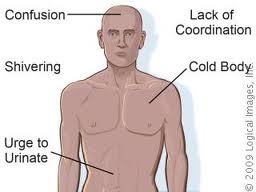When exposed to cold temperatures, your body begins to lose heat faster than it can be produced. Prolonged exposure to cold will eventually use up your body’s stored energy. The result is hypothermia, or abnormally low body temperature. Body temperature that is too low affects the brain, making the victim unable to think clearly or move well. This makes hypothermia particularly dangerous because a person may not know it is happening and won’t be able to do anything about it.
Hypothermia is most likely at very cold temperatures, but it can occur even at cool temperatures (above 40°F) if a person becomes chilled from rain, sweat, or submersion in cold water.
What are the symptoms of hypothermia?
When you first fall into cold water you gasp (torso reflex). Next, your skin begins to cool, and your body constricts surface blood vessels to conserve heat for your vital organs. Blood pressure and heart rate increase. Muscles tense and shiver; this produces more body heat, but results in a loss of dexterity and motor control. As your body’s core temperature drops further, blood pressure, pulse, and respiration rates all decrease.
As conditions worsen, your mental attitude and level of consciousness change. Resisting help and acting irrational or confused are common indicators of hypothermia. As your core temperature drops dangerously low, you become semiconscious, then unconscious. Stress, shock, and low core temperatures may cause cardiac and respiratory failure.
Hypothermia sneaks up on you, so you probably aren’t the best judge of whether or not you are hypothermic.
Signs that a person is nearing a hypothermic state include shivering, poor coordination, and mental sluggishness. As hypothermia progresses, shivering ceases, coordination is severely impaired, and confusion is coupled with incoherence and irrationality. Severely hypothermic people have icy skin. Extreme lethargy merges with unconsciousness and they might appear dead.
Since each individual reacts differently, the severity of hypothermia is best measured by taking a core temperature reading using a rectal thermometer. Oral measurements do not accurately measure changes in core temperature.
Prevention
Staying warm in cold weather
Before you or your children step out into cold air, remember the advice that follows with the simple acronym COLD — cover, overexertion, layers, dry:
- Cover. Wear a hat or other protective covering to prevent body heat from escaping from your head, face and neck. Cover your hands with mittens instead of gloves. Mittens are more effective than gloves because mittens keep your fingers in closer contact with one another.
- Overexertion. Avoid activities that would cause you to sweat a lot. The combination of wet clothing and cold weather can cause you to lose body heat more quickly.
- Layers. Wear loosefitting, layered, lightweight clothing. Outer clothing made of tightly woven, water-repellent material is best for wind protection. Wool, silk or polypropylene inner layers hold body heat better than cotton does.
- Dry. Stay as dry as possible. Get out of wet clothing as soon as possible. Be especially careful to keep your hands and feet dry, as it’s easy for snow to get into mittens and boots.
Treatment
If you recognize hypothermia in someone, take action. If the victim is unconscious, seek medical help immediately. If the victim is conscious, or after medical help has been sent for for an unconscious victim:
- Move the victim to shelter. Be very gentle with unconscious victims — their hearts are fragile and sensitive to jarring.
- Remove wet clothes, and replace them with warm, dry garments.
- If the victim is alert enough to hold a cup, give warm, but not hot, liquids to drink. Sugary drinks, such as warm Tang or Jello, are especially helpful. Never give food or drink to an unconscious victim — he or she may choke.
- If the victim is conscious and able, moderate exercise such as walking will help to generate heat.
- If the victim is unconscious or unable to exercise, place the victim in a sleeping bag to help speed rewarming, and insulate the sleeping bag with a plastic sheet (or a tarp) above and a pad below.




